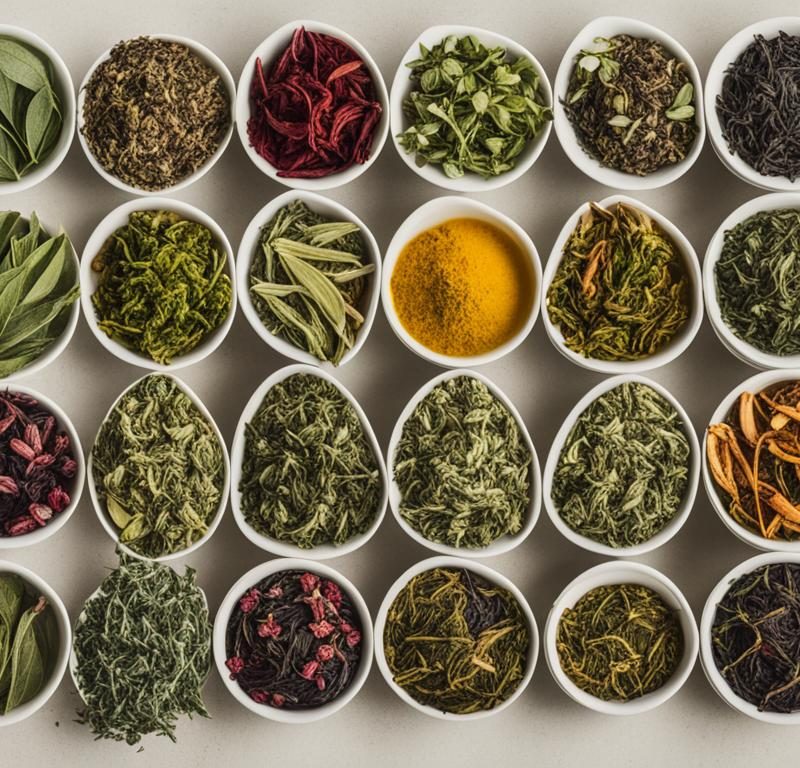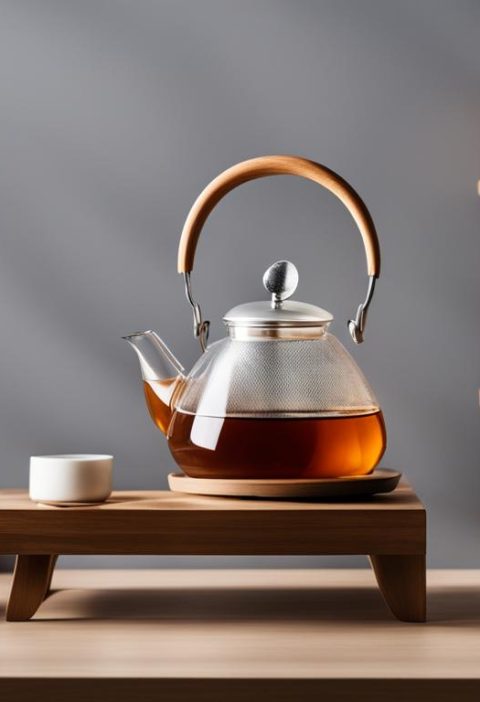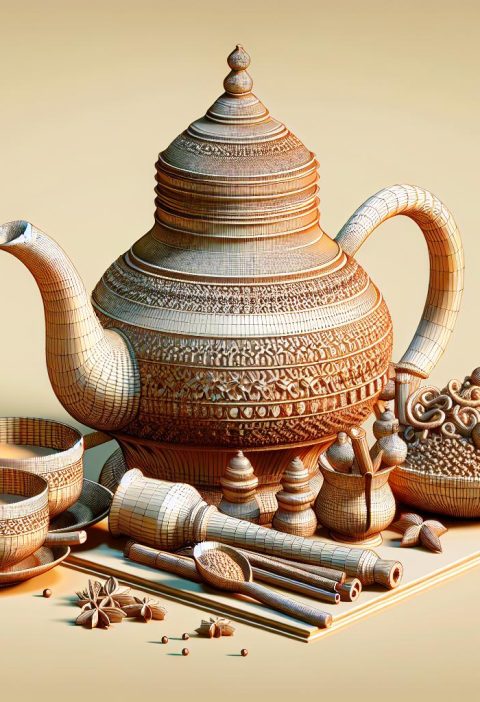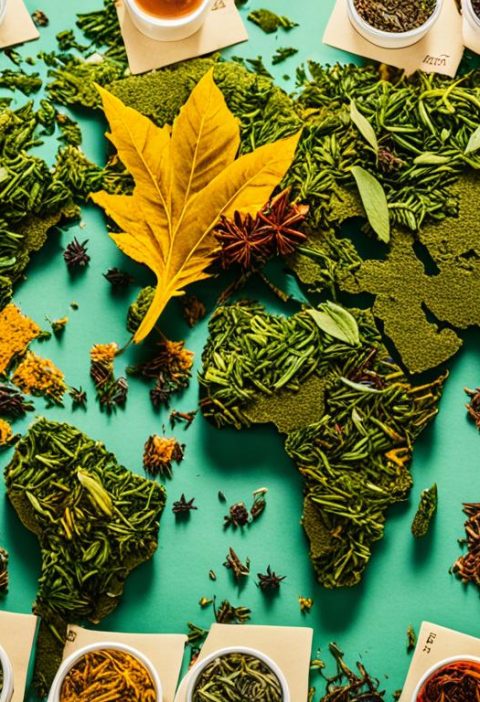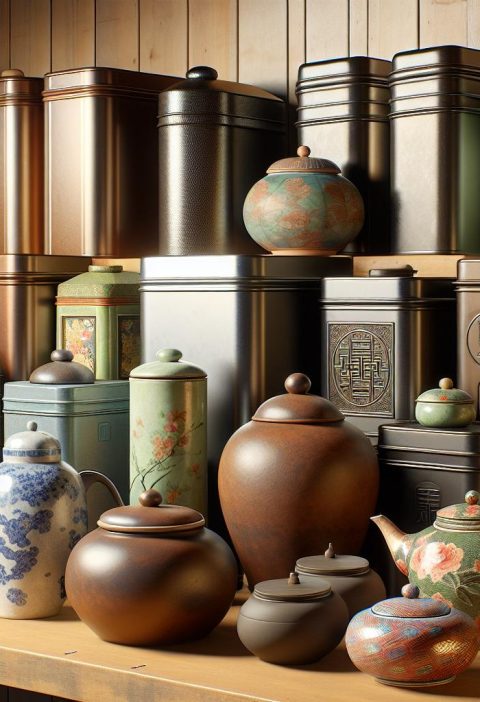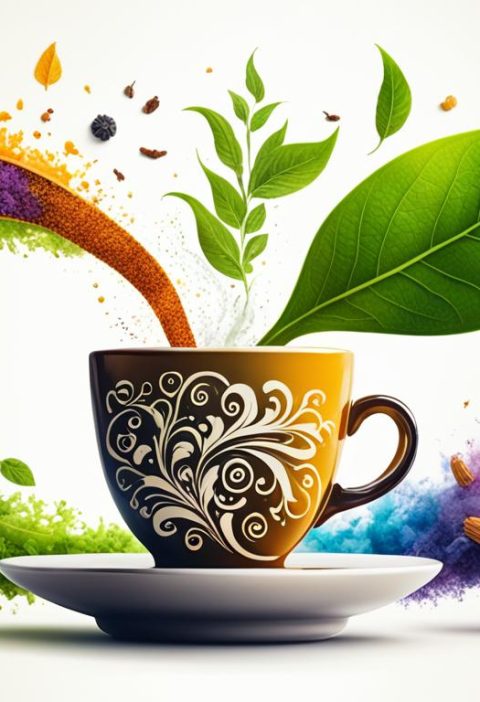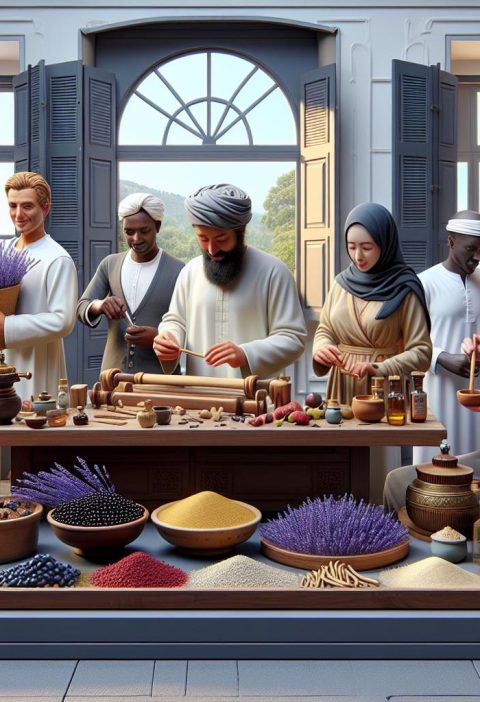Steeping herbal teas correctly is essential to ensure a flavorful and well-extracted infusion. Whether you’re steeping true teas or herbal teas (tisanes), there are some key factors to consider, including the type of tea, fresh ingredients, steeping time, and water temperature. By following our expert guide, you’ll be able to brew a perfect cup of herbal tea every time.
Types of Tea: True Teas vs. Herbal Teas
True teas, such as black, green, oolong, and white tea, are derived from the Camellia sinensis plant. These teas undergo oxidation and drying processes to create distinct flavors and antioxidant contents. On the other hand, herbal teas, also known as tisanes, are infusions or decoctions made from the roots, leaves, stems, or flowers of herbs and plants like chamomile, peppermint, hibiscus, or ginger. Both types of tea require different steeping techniques and variations in amounts, steeping time, and water temperature.
Importance of Fresh Ingredients
Using fresh ingredients in herbal tea steeping is crucial to achieving the best flavor and maximum health benefits. While dried tea leaves have a longer shelf life, extended storage times can affect the quality, flavor, and aroma of the tea. Fresh herbs, roots, or spices should be used shortly after they are cut or purchased. Additionally, the quality of water used in steeping also impacts the flavor of herbal tea. Fresh, cold, and filtered water is ideal for optimal taste.
The Role of Time and Temperature
Time and temperature play vital roles in herbal tea steeping. Steeping tea for too short a time may not extract all the flavors and antioxidants, while steeping for too long can result in bitterness. The proper temperature for steeping also varies depending on the type of herbal tea. For example, dried herbal teas like chamomile, peppermint, or hibiscus generally require boiling water and a steeping time of up to 15 minutes. On the other hand, green tea calls for lower temperatures around 65-85°C and shorter steeping times to preserve its delicate flavor profile. It’s important to consider the caffeine content, which increases with longer steeping times and higher water temperatures.
Hot Steeping Techniques and Guidelines
Hot steeping is the most common method for brewing herbal teas. Different teas have specific steeping times and temperatures for optimal flavor extraction. For example, white tea requires a water temperature of 175°F (79°C) and a steeping time of 4-5 minutes, while black tea needs a temperature of 195°F (91°C) and a steeping time of 3-4 minutes. It’s important to note that green tea is the most delicate and requires lower temperatures of 65-85°C and a slightly shorter steeping time.
Cold Steeping Techniques and Benefits
Cold steeping or cold brewing is an alternative method for making herbal tea, especially if you prefer iced tea. Cold steeping involves steeping tea in cold or room-temperature water for extended periods, usually 12 hours. This method produces a smoother-tasting tea with a higher antioxidant content. However, steeping at lower temperatures for a shorter time using hot water followed by adding ice can achieve similar taste and antioxidant levels. Cold steeping allows for a different flavor profile and can be a refreshing option during summer months.
Essential Tools and Techniques
While there are specialized tools available for brewing tea, you can also achieve excellent results with minimal equipment. Basic tea brewing requires a teacup or mug, tea bag or loose-leaf tea, and a kettle or pot for boiling water. For loose-leaf tea, a metal tea ball or infuser can be used to hold the leaves, while a tea strainer allows for the expansion and infusing of loose-leaf tea. Cold brew techniques often involve brewing tea in a larger container, like a mason jar, using an infuser or tea bag.
Importance of High-Quality Ingredients and Water
To ensure the best cup of herbal tea, it’s crucial to use high-quality tea leaves and fresh ingredients. Look for teas that come from reputable sources and are transparent about their origin and production methods. Loose-leaf tea often offers superior quality and a wider range of flavors compared to tea bags. Using pure water, preferably filtered, is essential for avoiding any off-flavors in your herbal tea.
The Art of Tea Vessels
The vessel from which you drink your herbal tea can enhance the overall tea-drinking experience. A variety of tea vessels are available, from elegant teacups to traditional Chinese or Japanese tea-making vessels like a gaiwan or yixing cup. Different teas may benefit from specific vessels, such as clay absorbing flavors and enhancing the overall taste of the tea. However, everyday kitchen cups or coffee mugs are suitable for a wide range of herbal teas, including green, oolong, black, and herbal teas.
The Perfect Cup: Temperature and Steeping Recommendations
Achieving the perfect cup of herbal tea involves following the recommended steeping temperatures and times. Each type of tea has its own optimal range, such as boiling water for herbal teas, around 85°C for oolong tea, or 65-85°C for green tea. It’s important to reference a steeping time chart for specific herbal teas to extract the best flavors and health benefits. Lastly, consider exploring different tea flavors and have fun experimenting with brewing techniques. Art of Tea offers a wide selection of teas, including loose-leaf teas and sachets, for you to explore and enjoy.
Key Takeaways:
- Types of tea: Differentiate between true teas (black, green, oolong, white) and herbal teas (tisanes).
- Fresh ingredients: Use fresh herbs, roots, or spices for optimal flavor and quality.
- Time and temperature: Steep tea for the recommended time and at the appropriate temperature to extract desired flavors.
- Hot steeping: Understand the specific guidelines for steeping various types of teas using hot water.
- Cold steeping: Discover the benefits and techniques for cold brewing herbal teas.
- Essential tools: Learn about the basic equipment needed for brewing perfect herbal tea.
- High-quality ingredients and water: Use premium tea leaves and fresh ingredients, along with pure or filtered water.
- Tea vessels: Explore different tea vessels and their impact on the tea-drinking experience.
- The perfect cup: Follow recommended steeping temperatures and times to achieve the best cup of herbal tea.
Types of Tea: True Teas vs. Herbal Teas
When it comes to tea, there are two main categories: true teas and herbal teas. Understanding the differences between these two types of tea is essential for mastering the art of steeping and brewing a perfect cup. Let’s explore!
True Teas
True teas, also known as “Camellia sinensis” teas, are derived from the leaves of the Camellia sinensis plant. This plant is native to East Asia and is responsible for the production of black, green, oolong, and white tea. What sets true teas apart is their oxidation and drying processes, which give them their distinctive flavors, aromas, and levels of antioxidants.
Herbal Teas
In contrast, herbal teas, also called tisanes, are not made from the Camellia sinensis plant. Instead, they are infusions or decoctions made from the roots, leaves, stems, or flowers of various herbs and plants. Common herbal teas include chamomile, peppermint, hibiscus, and ginger, each offering unique flavors and potential health benefits.
While both true teas and herbal teas can be enjoyed for their taste and wellness properties, it’s important to note that they require different steeping techniques. Let’s take a closer look at the steeping techniques for each type.
| True Tea | Herbal Tea |
|---|---|
| Derived from the Camellia sinensis plant | Infusions or decoctions made from various herbs and plants |
| Varieties include black, green, oolong, and white tea | Common herbal teas include chamomile, peppermint, hibiscus, and ginger |
| Requires specific steeping techniques based on the type of tea | Steeping techniques vary depending on the herbs and plants used |
As you can see, the differences between true teas and herbal teas go beyond their origins. To fully appreciate the flavors and benefits of each type, it’s important to understand their unique characteristics and steeping requirements. In the next sections, we’ll delve deeper into the steeping techniques, time, and temperature recommendations for both true teas and herbal teas, so you can brew the perfect cup every time.
Importance of Fresh Ingredients
Using fresh ingredients in herbal tea steeping is crucial to achieving the best flavor and maximum health benefits. While dried tea leaves have a longer shelf life, extended storage times can affect the quality, flavor, and aroma of the tea. Fresh herbs, roots, or spices should be used shortly after they are cut or purchased. Additionally, the quality of water used in steeping also impacts the flavor of herbal tea. Fresh, cold, and filtered water is ideal for optimal taste.
When it comes to herbal tea, the quality of the ingredients directly translates to the quality of the final brew. Fresh ingredients provide a vibrant flavor and aroma compared to their dried counterparts. The essential oils and volatile compounds within herbs and spices gradually degrade as they age. By using fresh ingredients, you ensure that these aromatic compounds are at their peak, resulting in a more satisfying and enjoyable cup of tea.
The table below highlights the key differences between using fresh ingredients and dried tea leaves in herbal tea steeping:
| Fresh Ingredients | Dried Tea Leaves | |
|---|---|---|
| Quality | High | Varies depending on storage conditions |
| Flavor | Bright and vibrant | May lose certain flavor nuances |
| Aroma | Fragrant and aromatic | May be less pronounced |
| Health Benefits | Maximized due to fresh, potent ingredients | Some antioxidant content may degrade over time |
Investing in high-quality, fresh ingredients for your herbal tea not only enhances the taste and aroma but also maximizes the potential health benefits. Fresh herbs, roots, and spices are packed with essential vitamins, minerals, and antioxidants that contribute to overall well-being.
Image:
The Role of Time and Temperature
Time and temperature are two crucial factors that greatly impact the quality and flavor of herbal tea. Proper steeping time and water temperature can make all the difference between a delightful cup of herbal tea and a disappointing brew.
Steeping Time:
The steeping time refers to the duration for which the tea leaves or herbs are allowed to infuse in hot water. Steeping for too short a time may result in a weak and under-extracted flavor, while steeping for too long can lead to a bitter and overpowering taste. It is essential to follow the recommended steeping times for different herbal teas to achieve the desired flavor profile.
- Dried herbal teas such as chamomile, peppermint, or hibiscus generally require longer steeping times of up to 15 minutes to fully extract their flavors and beneficial compounds.
- Green tea, on the other hand, requires shorter steeping times of around 2-3 minutes to preserve its delicate flavor and prevent the release of any unwanted bitterness.
Water Temperature:
The water temperature used for steeping herbal teas also affects the final taste and quality of the brew. Different types of teas require varying water temperatures to achieve optimal extraction and flavor retention.
- Dried herbal teas can generally be steeped in boiling water (100°C) to ensure maximum flavor extraction. The boiling water helps to release the aromatic oils and constituents present in the herbs.
- Green tea, on the other hand, should be steeped in water temperatures ranging from 65-85°C. This lower temperature helps to preserve the delicate flavors and prevents the tea from becoming bitter.
Caffeine Content:
It’s important to note that the steeping time and water temperature can also impact the caffeine content of herbal tea. The longer the tea is steeped and the higher the water temperature, the more caffeine is extracted from the tea leaves or herbs. If you’re sensitive to caffeine, you may consider opting for shorter steeping times or using lower water temperatures to reduce the caffeine content in your herbal tea.
By carefully considering the steeping time and water temperature, you can ensure that you fully extract the flavors, aroma, and health benefits from your herbal tea, resulting in a satisfying and enjoyable cup every time.
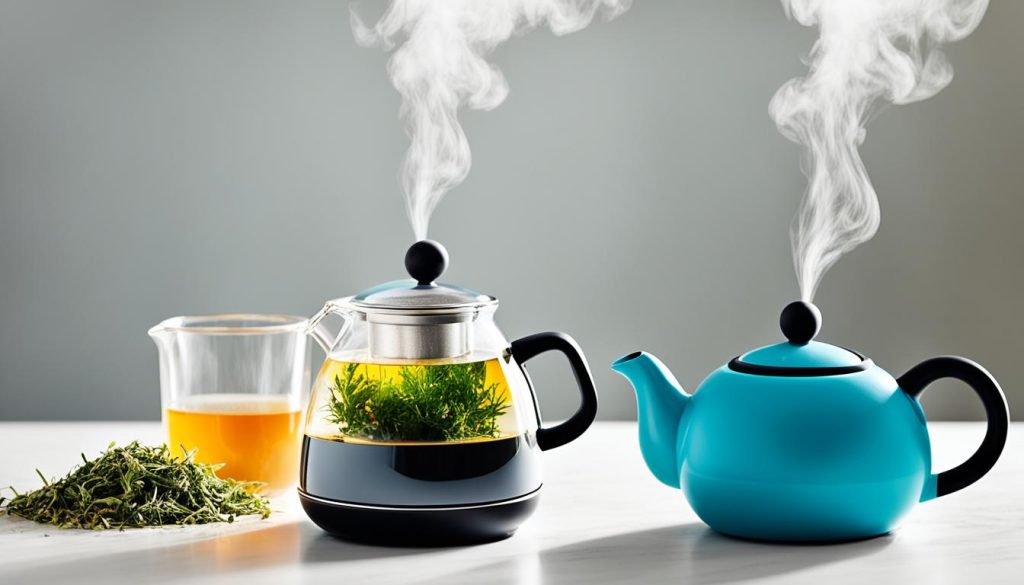
Hot Steeping Techniques and Guidelines
Hot steeping is the most common method for brewing herbal teas. When it comes to hot steeping, it’s crucial to consider the steeping temperature and time to achieve the best flavor extraction. Different teas have specific requirements, so let’s take a look at some popular teas and their recommended steeping parameters:
Guide to Hot Steeping Temperatures and Times for Popular Teas
| Tea Type | Steeping Temperature | Steeping Time |
|---|---|---|
| White Tea | 175°F (79°C) | 4-5 minutes |
| Black Tea | 195°F (91°C) | 3-4 minutes |
| Green Tea | 65-85°C | 2-3 minutes |
| Oolong Tea | 185-205°F (85-96°C) | 3-5 minutes |
| Herbal Tea (e.g., Chamomile, Peppermint, Hibiscus) | Boiling water (212°F, 100°C) | 5-15 minutes |
Remember, green tea is the most delicate and requires lower temperatures and a shorter steeping time. Now that you have a general idea of the steeping parameters, you can confidently brew your favorite herbal teas for the perfect aroma and flavor!
Cold Steeping Techniques and Benefits
When it comes to making herbal tea, cold steeping offers a delightful alternative, particularly if you enjoy iced tea. Cold steeping involves the process of steeping tea in cold or room-temperature water for an extended period, typically around 12 hours. This unique method creates a smoother and more flavorful tea with a higher antioxidant content.
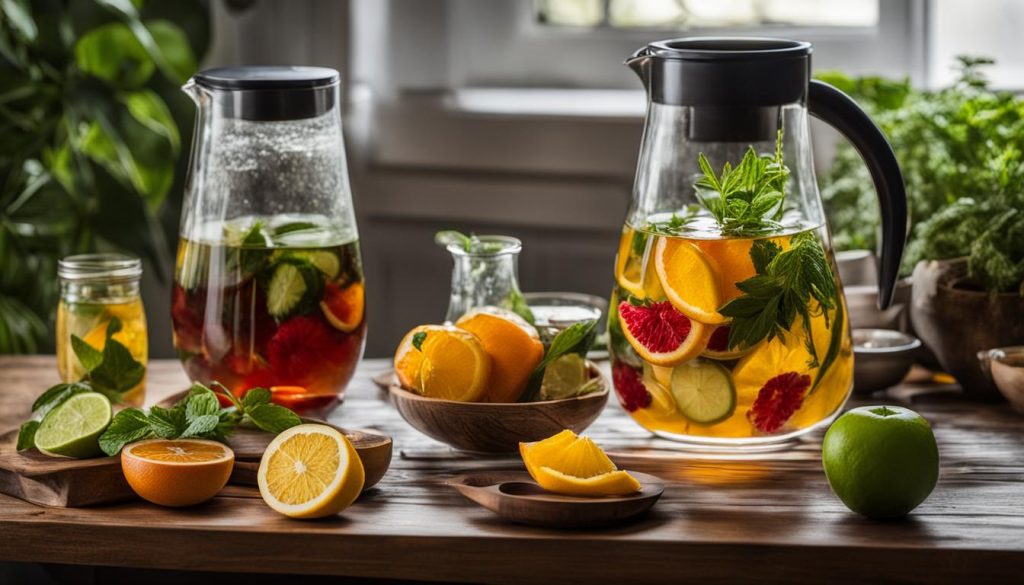
By steeping tea at a low temperature for a longer duration, the flavor extraction is gentle, resulting in a milder yet more complex taste profile. The extended steeping time allows the flavors to develop fully, ensuring a well-rounded and satisfying cup of tea.
The benefits of cold steeping extend beyond taste. Cold steeped tea generally contains a higher concentration of antioxidants compared to traditional hot brewing methods. These antioxidants contribute to various health benefits, including reducing inflammation and promoting heart health.
If you crave the flavor and benefits of cold steeping but don’t have the time to wait, there’s a simple alternative. Steeping your tea at a lower temperature for a shorter duration using hot water, followed by the addition of ice, can achieve similar taste and antioxidant levels. This method offers a quicker way to enjoy a refreshing iced tea without sacrificing flavor or health benefits.
Cold steeping is an excellent choice during the summer months when you desire a cool and refreshing beverage. It allows you to experiment with different tea varieties, creating unique flavor combinations and enjoying a different tea experience.
Essential Tools and Techniques
When it comes to brewing tea, you don’t need a lot of fancy equipment to achieve excellent results. With just a few basic tools, you can enjoy a perfect cup of tea every time.
Tea Brewing Tools
- Teacup or Mug
- Tea Bag or Loose Leaf Tea
- Kettle or Pot for Boiling Water
- Metal Tea Ball or Infuser (for Loose Leaf Tea)
- Tea Strainer (for Expansion and Infusing of Loose Leaf Tea)
Whether you prefer tea bags or loose leaf tea, having a reliable teacup or mug is essential. Look for one that suits your personal style and holds the right amount of tea for your enjoyment.
When using loose leaf tea, a metal tea ball or infuser can be a convenient way to hold the leaves while allowing them to steep and release their flavors into the water. Alternatively, you can use a tea strainer to strain out the leaves and ensure a smooth, enjoyable cup of tea.
Cold Brew Tea Techniques
If you’re a fan of cold brew tea or iced tea, you can experiment with different techniques to achieve a refreshing and flavorful result.
For cold brew techniques, you can use a larger container, such as a mason jar, and add an infuser or tea bag. This allows the tea leaves to steep in cold or room-temperature water for an extended period, usually around 12 hours. The result is a smoother and less bitter-tasting tea with a higher antioxidant content.
Alternatively, you can start by steeping the tea at a lower temperature using hot water and then adding ice to cool it down. This method achieves similar taste and antioxidant levels, albeit with a slightly different flavor profile.
Whether you prefer hot or cold brew techniques, the key is to experiment and find the brewing method that suits your taste preferences.
| Brewing Key Points | Hot Steeping Techniques | Cold Steeping Techniques |
|---|---|---|
| Tools Needed | Teacup, Kettle, Tea Bag/Loose Leaf Tea, Tea Ball/Infuser, Tea Strainer | Larger Container (Mason Jar), Infuser/Tea Bag |
| Steeping Time | Varies based on tea type and desired strength | Around 12 hours |
| Water Temperature | Dependent on tea type (e.g., boiling for herbal tea, lower temperature for green tea) | Cold or room temperature |
| Flavor Profile | Varies based on tea type and steeping time | Smooth, less bitter taste |
| Antioxidant Content | Varies based on tea type and steeping time | Higher antioxidant content |
Importance of High-Quality Ingredients and Water
To ensure the best cup of herbal tea, we understand the significance of using high-quality tea leaves and fresh ingredients. When choosing your tea, look for reputable sources that are transparent about the origin and production methods. Opting for loose leaf tea instead of tea bags often provides a superior quality and a wider range of flavors. Image alt tag: high-quality tea
| Key Factors | Benefits |
|---|---|
| High-Quality Tea Leaves | Superior quality and more flavor options |
| Transparent Sourcing | Confidence in origin and production procedures |
| Fresh Ingredients | Enhances taste and health benefits |
| Pure, Filtered Water | Prevents off-flavors in your herbal tea |
In addition to high-quality tea leaves, using pure water is crucial in avoiding any unwanted flavors in your herbal tea. Opt for filtered water whenever possible to ensure a clean and refreshing taste. Remember, every ingredient matters when it comes to brewing your perfect cup of herbal tea.
The Art of Tea Vessels
The vessel from which you drink your herbal tea plays a crucial role in enhancing the overall tea-drinking experience. Different tea vessels offer unique features that can elevate your enjoyment of herbal teas. Whether you prefer elegant tea cups, traditional Chinese or Japanese tea-making vessels, or everyday kitchen cups or coffee mugs, there is a vessel suitable for your needs.
Traditional tea-making vessels, such as a gaiwan or yixing cup, are widely used in Chinese and Japanese tea ceremonies. These vessels are designed to enhance the flavors and aromas of the tea, allowing you to fully appreciate the intricacies of each sip. The use of clay vessels, such as yixing cups, is particularly favored as the clay can absorb flavors over time, infusing subsequent brews with a richer taste.
For a more casual tea-drinking experience, everyday kitchen cups or coffee mugs are perfectly suitable. These vessels offer convenience and comfort, allowing you to enjoy a wide range of herbal teas, including green, oolong, black, and herbal teas. The most important factor is to choose a vessel that brings you joy and enhances your tea-drinking experience.
Explore the variety of tea vessels available and find the one that resonates with your style and preferences. Whether it’s a beautifully crafted tea cup or a traditional tea-making vessel, the right choice can transform your herbal tea into a truly immersive and delightful experience.
The Perfect Cup: Temperature and Steeping Recommendations
Achieving the perfect cup of herbal tea involves following the recommended steeping temperatures and times. Each type of tea has its own optimal range. For herbal teas, boiling water is ideal to extract the flavors and health benefits. Oolong tea, on the other hand, requires a temperature of around 85°C. Green tea, known for its delicate flavor, should be steeped between 65-85°C.
To ensure the best infusion, it is essential to reference a steeping time chart specific to herbal teas. This chart will guide you on the ideal steeping duration for different herbal teas, allowing you to extract the fullest flavors and maximize the health benefits.
While following these recommendations is important, don’t be afraid to explore and have fun with different tea flavors and brewing techniques! The world of herbal teas is vast and varied, with endless possibilities to discover. If you’re looking to expand your tea collection, consider visiting the Art of Tea shop. They offer a wide selection of teas, including both loose leaf teas and convenient sachets, for you to explore and enjoy.
